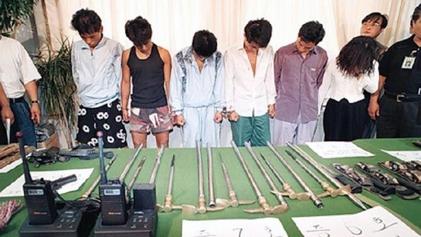
d: 1995
Kim Gi-hwan
Summary
Name:
Kim Gi-hwanYears Active:
1993 - 1994Status:
ExecutedClass:
Serial KillerVictims:
5Method:
Shooting / Strangulation / Suffocation / Stabbing / Bludgeoning / CannibalismDeath:
November 02, 1995Nationality:
South Korea
d: 1995
Kim Gi-hwan
Summary: Serial Killer
Name:
Kim Gi-hwanStatus:
ExecutedVictims:
5Method:
Shooting / Strangulation / Suffocation / Stabbing / Bludgeoning / CannibalismNationality:
South KoreaDeath:
November 02, 1995Years Active:
1993 - 1994bio
Kim Gi-hwan was born in South Korea in the late 1960s and grew up in poverty. Despite his difficult circumstances, he was an intelligent student, excelling academically and even achieving an amateur rank in the board game baduk (Go). However, frequent school absences caused by financial hardship eventually led him to leave education at the age of thirteen.
After dropping out, Kim worked in shoe and plywood factories in Busan before moving to Seoul to perform hard manual labor. During these years, he developed an obsessive fixation on social inequality. Media reports about bribery and corruption in South Korea’s elite university admissions system left him furious, and he began to speak openly about punishing those he saw as beneficiaries of an unjust system.
Kim’s criminal record began when he raped the niece of a former friend, for which he was sentenced to five years in prison. There, he met other disaffected and unemployed young men with similar backgrounds of poverty and resentment. Upon his release, he envisioned creating an organized group that would “take revenge on the rich” through kidnapping, extortion, and murder.
murder story
In the summer of 1993, Kim Gi-hwan met fellow ex-convicts Moon Sang-rok and Kim Hyun-yang at a poker game. The three bonded over their anger toward wealthy elites. That evening, they agreed to form a gang and create a doctrine built on hatred and violence. Over the following weeks, they recruited additional members, many of whom had prior convictions for robbery and theft. Eventually, seven male members and one female associate formed the group.
Pooling their resources, they purchased vehicles, firearms, explosives, and even constructed a base with prison cells and an incineration facility. Their ultimate plan was to amass one billion won (about $1.25 million in 1993) through kidnapping and extortion. The group’s doctrine emphasized hatred for the wealthy, betrayal punishable by death, and mistrust of women.
The gang’s first practice crime was the abduction of Miss Choi, a 20-year-old farmer’s daughter, on July 18, 1993. She was gang-raped, strangled, and killed as a demonstration of how to murder without hesitation. Her body was later discovered, though no immediate suspects were identified.
Shortly afterward, internal tensions emerged. One member, Song Bong-un, attempted to flee with gang funds. The others tracked him down, executed him by shooting, and buried his body. The murder was both an act of discipline and a warning to others within the group.
The Chijon Family’s crimes escalated dramatically in 1994. On September 8, 1994, the gang abducted café worker Lee Jeong-su and her boyfriend, a 34-year-old musician driving a luxury Hyundai Grandeur. Mistaking the couple for wealthy elites, they kidnapped them, imprisoned them in their underground facility, and eventually forced Lee to suffocate her boyfriend with plastic wrap. The man’s body was placed in his car, which the gang pushed off a cliff to simulate an accident. Lee herself was repeatedly assaulted but spared for a time.

Five days later, on September 13, 1994, the gang abducted Mr. So, a 42-year-old factory owner, and his wife, Mrs. Park, while they were tending to a family grave. They demanded 100 million won in ransom. Although Mr. So delivered most of the money, the gang executed both him and his wife. Members dismembered the bodies, burned the remains, and even engaged in cannibalism, claiming it was a ritual to sever ties with their humanity. To conceal the smell of burning flesh, the gang barbecued pork outside the facility and invited villagers to join.
The turning point came with Lee Jeong-su’s escape. Initially forced to participate in crimes, she managed to flee while receiving hospital treatment for burns sustained in dynamite practice. She reached Seoul, contacted a friend, and reported the crimes to police. At first, authorities doubted her story, suspecting drug use or mental illness. However, investigator Go Byung-cheon recognized that she described details of missing persons not yet reported publicly. Her testimony prompted a full-scale investigation.
Police traced the gang through phone records and surveillance. On September 19, 1994, they arrested member Kang Dong-un and then lured the others into a trap by pretending he had been hospitalized after an accident. All remaining members, including Kim Gi-hwan, were captured.
On November 1, 1994, Kim Gi-hwan and the other male members of the Chijon Family were sentenced to death for the murders of five confirmed victims. Only Lee Kyung-sook, the girlfriend of one member who did not directly participate in killings, received a lighter sentence. Throughout their trial, the gang showed no remorse. Member Kim Hyun-yang told reporters that his only regret was not killing more rich people. On November 2, 1995, Kim Gi-hwan and the other convicted gang members were executed by hanging at Seoul Detention Center.